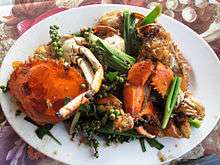Kampot (pepper)


Kampot pepper is a cultivar of pepper (piper nigrum) grown and produced in Kampot Province, Cambodia. It is a certified appellation of origin product since 2010.
Production
Kampot pepper is organically grown and produced and sold in green, black, white and red varieties, all from the same plant.[1] The climate of Kampot Province offers perfect conditions for growing pepper and the quartz content of the soil in the foothills of the Elephant Mountains helps to give Kampot pepper its unique terroir.[2][3][2]
The growing conditions are only one of several elements of importance to the production of Kampot pepper. Knowledge of pepper cultivation and production has been handed down from generation to generation in Kampot Province since at least the 13th century.[4] Storage conditions are also of importance and different qualities of Kampot pepper are produced and sold.[3]
Plantations are inspected by the Kampot Pepper Producers Association (KPPA) and by the independent certification body Eco-Cert. Only accredited members of the KPPA, adhering to the PGI criteria, are authorised to sell pepper using the “Kampot Pepper” appellation of origin. In 2015, a year of drought, the production amounted to 50 tonnes and it is expected to increase to 500 tonnes in 2018.[4]
History
Kampot pepper cultivation has a long history and was first described in the 13th century, during the Angkorian era, when the Chinese diplomat Zhou Daguan visited the area.[5] Modern intensive production was initiated under the French colonial rule in the 1870s and at the beginning of the 20th century, Cambodia harvested around 8,000 tons of Kampot pepper annually. In the 1960s, there were still 1 million pepper poles in Kampot, producing around 1,000 tons per year, but the production was severely affected by the Cambodian civil war and only 4 tons per year were harvested by the end of the 1990's.[3]
Kampot pepper production slowly gained momentum in the 2000's when previous pepper farmers gradually returned to their lands.[4][6] As of July 2015, six districts in the southern province of Kampot have pepper farms, while the spice’s overseas market consists mostly of Europe, the United States, Japan, Korea, and Taiwan.[7] As the first Cambodian product, Kampot pepper obtained the World Trade Organization’s Geographical Indication (GI) status in 2010, tying the quality of the product to its origin.[2] International demand for the product has risen since then. However, annual export volume is still relatively small, i.e. 58 tonnes was produced on 25 hectares for the year 2014.[8]
Use
Apart from the peppercorns, the stalks of Kampot pepper are also eaten, as in Kep, Cambodia where they are pan fried with squid at the Crab Market.[9]
-

Kampot pepper crab featuring green Kampot peppercorns, garlic and spring onion.
-

Cambodian prawns with Kampot Pepper.
Pepper in Cambodia
Pepper is an increasingly popular crop in Cambodia, not just in Kampot Province. In 2016, as of the end of May, Cambodia had produced a total of 11,819 tonnes of black pepper, an increase of 20% compared to the same period of 2015. About 72% of that came from Tbong Khmum, which has over 2,762 hectares of pepper farmland. Comparably, Vietnam tops the list of pepper growing nations with a total crop of 155,000 tons in 2014; a 38.6 % share of the global production.[10]
The world market price for pepper is currently favorable and many new pepper plantations are constructed across the country. In some regions, large pepper plantations are contributing to the already alarming deforestation in Cambodia.[10]
References
- ↑ "Kampot Pepper". kampotpepper.biz. KPPA. Retrieved 16 November 2016.
- 1 2 3 Meredith Bethune (April 2014). "How the World's Best Pepper is Grown in Kampot, Cambodia". Serious Eats. Retrieved 16 November 2016.
- 1 2 3 "Kampot Pepper". Farmlink. Retrieved 16 November 2016.
- 1 2 3 "The Region of Kampot". La Plantation Management Ltd. Retrieved 16 November 2016.
- ↑ George Edgar (1 November 2016). "Reaping what you sow". The Phnom Penh Post. Retrieved 16 November 2016.
- ↑ Vong Sokheng (11 April 2003). "Daily grind for pepper paupers". The Phnom Penh Post. Retrieved 16 November 2016.
- ↑ Sok Chan (8 July 2015). "High 2015 yields for pepper growers". The Phnom Penh Post. Retrieved 16 November 2016.
- ↑ Cheng Sokhorng (13 November 2015). "Kampot pepper defying drought fears". The Phnom Penh Post. Retrieved 16 November 2016.
- ↑ Cambodia's Fresh Cuisine July 2011 Conde Nast Traveler page 30
- 1 2 Mech Dara, Igor Kossov (14 June 2016). "Pepper business adds to Kingdom's deforestation woess". The Phnom Penh Post. Retrieved 16 November 2016.
External links
- KPPA: Kampot Pepper Producers website